2. 南方海洋科学与工程广东省实验室, 珠海 519000;
3. 辽宁省地质矿产调查院, 沈阳 110031
2. Southern Marine Science and Engineering Guangdong Laboratory, Zhuhai 519000, China;
3. Liaoning Survey Academy of Geology and Mineral Resources, Shenyang 110031, China
作为中国最古老的克拉通之一,华北克拉通的地质演化一直是国际前寒武纪地质研究的热点(Zhao et al., 2001; Zhai et al., 2002; Zhai and Santosh, 2011; Zhao and Cawood, 2012; Zheng et al., 2013)。有的学者认为在太古宙末期,华北克拉通完成了不同陆块之间的拼贴(Kusky et al., 2001;翟明国, 2012),后又经历了古元古代构造热事件的改造,以辽-吉活动带、丰镇活动带以及晋豫活动带为特征(翟明国和彭澎, 2007;翟明国, 2011)。近些年,大量的研究揭示出华北克拉通是由不同陆块沿着三条古元古代活动带(即胶-辽-吉活动带、孔兹岩带、中部造山带)在古元古代末期拼贴碰撞形成(Zhao et al., 2005, 2012; Zhao and Zhai, 2013;李三忠等, 2015)。同时,这些古元古代活动带可以很好的与全球同时期(2.1~1.9Ga)造山带进行对比,整体记录了Columbia超大陆的聚合事件(Zhao et al., 2004; Li et al., 2010; Zhang et al., 2012, 2015;李三忠等, 2015)。其后,伴随着Columbia超大陆的裂解,华北克拉通内部及边缘分别发育了三条中元古代裂谷带,即北缘的渣尔泰-白云鄂博-化德裂谷带,中北部的燕辽裂谷带,以及南缘的熊耳裂谷带(Zhai et al., 2000;翟明国, 2004; Peng et al., 2011; Zhai and Santosh, 2011;刘超辉和刘福来, 2015),并广泛发育了中元古代的沉积盖层(Zheng et al., 2013)。就全球地质历史演化而言,结晶基底的形成标志着古元古代的结束,而稳定盖层的发育标志着中元古代的开始(赵太平等, 2015)。所以稳定盖层最底部沉积岩系(如长城系底部)起始沉积年龄的研究,可以为限定华北克拉通古-中元古代的界限提供一定佐证。此外,稳定盖层底部沉积岩系的沉积时代、物源区及沉积环境的研究能够对克拉通的地壳增生事件及构造演化进行很好的制约。
前人已对华北克拉通三条中元古代裂谷带进行了大量研究,并在年代学方面取得了诸多进展。例如,前人在渣尔泰-白云鄂博-化德裂谷带中的白云鄂博群和渣尔泰群基性火山岩中获得1728Ma和1743Ma的锆石年龄(Lu et al., 2002; Li et al., 2007);燕辽裂谷带内中元古代火山岩的发现,包括1637~1622Ma长城系团山子组和大红峪组中的富钾火山岩(Lu et al., 2002;张拴宏等, 2013);南侧的熊耳裂谷带中熊耳群和西洋河群火山岩年龄主要集中在1.78~1.75Ga(Zhao and Zhou, 2009;赵太平等, 2015),熊耳群底部的大古石组起始沉积年龄1.8~1.76Ga(赵太平等, 2015)。然而,对于不整合于克拉通结晶基底上的沉积盖层底部岩系的研究相对薄弱,至今尚未获得一致的长城系起始沉积年龄(和政军等,2011;李怀坤等,2011;彭澎等,2011;赵太平等, 2015;张艳斌和李秋立,2017)。前人对长城系底部沉积岩系的研究多数集中在天津蓟县剖面及其附近地区(乔秀夫和高林志, 2007;宋天锐, 2007;张拴宏等, 2013)。考虑到华北克拉通不同地区盖层沉积开始发育的时间可能存在区域性差异,因此本文选取发育于燕辽裂谷带东北缘盖州-庄河地区的榆树砬子岩组作为研究对象。
近期的野外填图工作表明,由于榆树砬子岩组直接与古元古代辽河群变质岩系接触,其很可能代表了该地区不整合覆盖于华北克拉通结晶基底之上的最老沉积盖层。因此榆树砬子岩组的沉积时代及层序可以为该地区克拉通化后初始沉积盖层的时代提供制约。此外,其物源区和沉积环境也能为华北克拉通结晶基底的构造演化提供重要信息。然而,围绕榆树砬子岩组的年代归属争议仍然较大,有的学者认为榆树砬子岩组为古元古代辽河群的一部分(姜春潮, 1987);有的学者依据地层接触关系将其置于中-新元古代(于海峰等, 2010)。总体来说,该岩组一直缺乏年代学、同位素地球化学及区域地层对比等相关证据。因此本文在详实的野外填图工作基础上,通过岩石学、锆石U-Pb年代学以及Hf同位素示踪等手段对榆树砬子岩组的岩石组合、形成时代及物源区进行了系统的研究,为华北最终克拉通化的时限和陆壳演化提供新的制约。
1 区域地质概况辽东半岛位于华北克拉通东部陆块东北缘,北邻中亚造山带、西邻燕辽裂谷带(图 1a)。主要由龙岗地块和辽南陆块的太古宙结晶基底、古元古代辽河群、古元古代辽吉花岗岩组成。辽河群为一套遭受低绿片岩-角闪岩相变质作用的火山-沉积岩系,总体呈NE向展布(Zhao et al., 2005;杨成会等, 2018),以盖县-析木城-塔子岭-草河口-叆阳(营口-草河口复向斜轴)一线,分南、北辽河群(Li and Zhao, 2007)。同时,活动带亦出露多期次不同类型花岗质岩石、双峰式火山岩、基性岩墙、高压基性麻粒岩和高压泥质麻粒岩等(Lu et al., 2002; Zhou et al., 2008; Tam et al., 2011;田忠华等, 2017)。
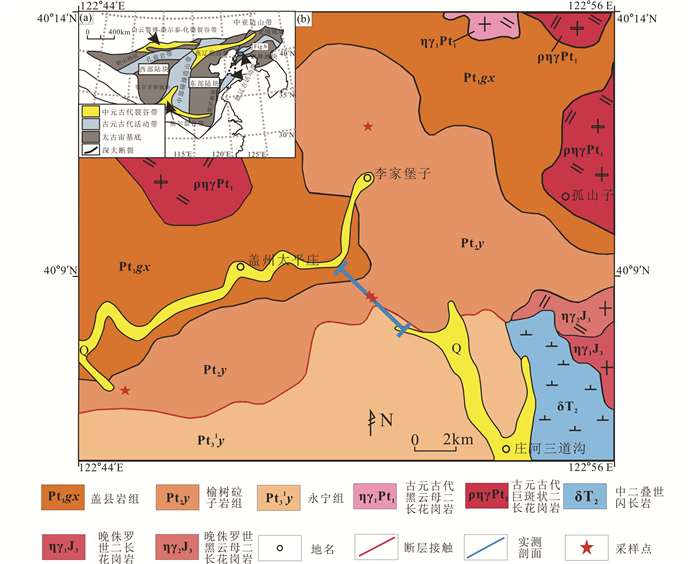
|
图 1 辽东半岛盖州-庄河地区大地构造位置(a, 据Zhao et al., 2005修改)和区域地质略图及采样位置(b) Fig. 1 Tectonic location of the Gaizhou-Zhuanghe area in the Liaodong Peninsula (a, modified after Zhao et al., 2005) and simplified regional geological map with the sampling locations (b) |
研究区位于辽东半岛盖州市太平庄-庄河市三道沟一带,地层单位自下而上主要出露盖县岩组、榆树砬子岩组及永宁组,侵入岩主要为古元古代花岗质岩石及中生代岩浆岩(图 1b)。盖县岩组主要由千枚岩、硬绿泥石片岩、绢云母片岩、二云母片岩、十字石云母片岩、夕线石云母片岩、变粒岩、变质石英砂岩等变质碎屑岩组成。榆树砬子岩组为一套绿片岩相浅变质的岩石组合,其宏观层序性、原生层理及沉积构造均较好保留(于海峰等, 2010),主要由巨厚层石英岩夹片岩、绢云母石英片岩、碎裂石英岩、绢云母石英岩组成。永宁组形成于河流相的沉积环境,其下部为变质砾岩、变质长石石英砂岩夹少量二云片岩,中部为碳质绢云板岩与二云片岩互层,上部为厚层的变质长石石英砂岩。砂岩中发育槽状交错层理、平行层理、板状斜层理等原生沉积构造。研究区内,由于中生代岩浆岩侵位作用影响,大部分永宁组发生热接触变质作用。古元古代花岗质岩石主要以中粒巨斑状黑云母二长花岗岩(卧龙泉岩体)、中细粒黑云母二长花岗岩(坎子岩体)为主。中生代岩浆岩发育有晚侏罗世中细粒黑云母二长花岗岩、中三叠世闪长岩等。
2 岩石学特征榆树砬子岩组主要分布在盖州市太平庄、猫岭村、庄河市天门山、三道沟等地,以猫岭村至三道沟一带出露最佳,面积约170km2。实测剖面(起点坐标:40°10′2″N、122°50′27″E)表明,其主要由绢云母石英片岩、石英岩、绢云母石英岩夹绢云母长英质千枚岩组成,与下伏辽河群盖县岩组呈角度不整合接触,与上覆永宁组呈构造接触(图 2)。
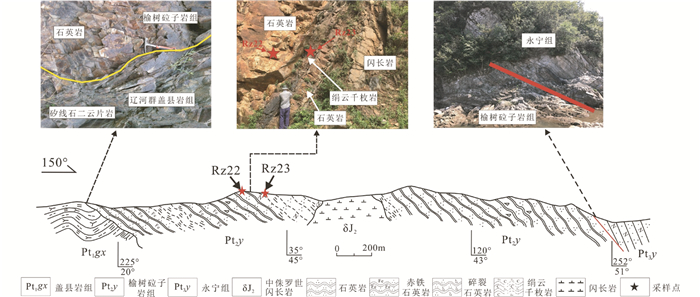
|
图 2 盖州猫岭-庄河三道沟榆树砬子岩组实测地质剖面(PM14) Fig. 2 Geological profile (PM14) of the Yushulazi Formation in the Gaizhou Maoling-Zhuanghe Sandaogou area |
绢云母石英片岩(图 3a, b,Rz20采样位置:40°12′53″N、122°50′59″E):褐红色,片状构造,主要矿物成分为石英和少量绢云母、赤铁矿。石英含量约为90%,他形粒状,粒度一般0.2~1mm,拉长定向排列,波状消光现象发育,少部分具带状消光现象,可见亚颗粒现象;绢云母含量约为5%,鳞片状,粒度 < 0.1mm,定向分布;赤铁含量约为5%。
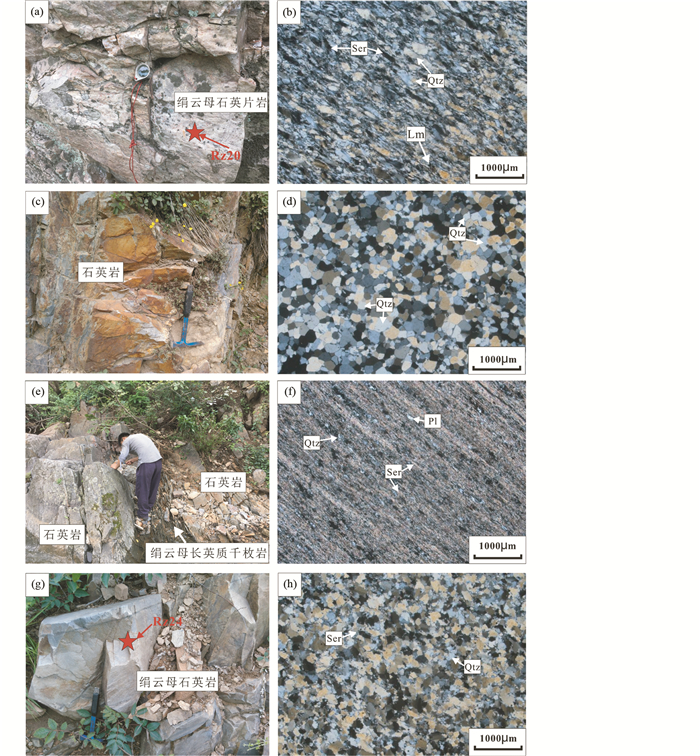
|
图 3 盖州-庄河地区典型榆树砬子岩组野外及显微照片 绢云母石英片岩采样照片(a)和显微照片(b);石英岩、绢云母长英质千枚岩采样照片(c、e)和显微照片(d、f);绢云母石英岩采样照片(g)和显微照片(h). Ser-绢云母;Qtz-石英;Lm-褐铁矿;Pl-斜长石 Fig. 3 Photographs and micrographs of the representative Yushulazi Formation in the Gaizhou-Zhuanghe area Sample photograph (a) and micrograph (b) of ferruginous quartzite; Sample photographs (c, e) and photomicrographs (d, f) of quartzite and sercited felsic phyllite; Sample photograph (g) and micrograph (h) of sercited quartzite. Ser-sericite; Qtz-quartz; Lm-limonite; Pl-Plagioclase |
石英岩(图 3c, d,Rz22采样位置:40°9′25″N、122°51′24″E):灰白色,粒状变晶结构,块状构造,主要矿物成分为石英和少量绢云母。石英含量大于95%,呈粒状,粒度一般0.1~0.5mm,少量粒度 < 0.1mm,不具定向特征,构成岩石主体,重结晶作用明显。绢云母含量小于5%,鳞片状,粒度 < 0.2mm,零散分布。
绢云母长英质千枚岩(图 3e, f,Rz23采样位置:40°9′11″N、122°51′37″E):灰黑色,鳞片状变晶结构,千枚状构造,主要矿物成分为长石、石英、绢云母和少量黑云母、铁氧化物组成。长英质含量约为75%,微粒状,粒度0.01~0.05mm,少量为0.05~0.1mm,拉长定向排列,颗粒细小。绢云母含量约为20%,微鳞片状,片径 < 0.1mm,少量与铁氧化物混杂,集合体定向分布。黑云母含量小于5%,微鳞片状,片径 < 0.1mm,定向分布,少量具褐铁矿化。铁氧化物含量小于5%,呈尘点状,与绢云母混杂,定向分布。
绢云母石英岩(图 3g, h,Rz24采样位置:40°7′41″N、122°45′34″E):灰白色,粒状变晶结构,块状构造,主要矿物成分为石英和绢云母。石英含量约为95%,他形粒状,粒度0.1~0.7mm,不具定向特征,具波状消光,局部可见亚颗粒,构成岩石主体,动态重结晶作用明显。绢云母含量约为5%,鳞片状,粒度 < 0.1mm,零散分布于石英粒间。
3 分析方法 3.1 LA-ICP-MS锆石U-Pb定年样品破碎和锆石挑选在河北廊坊区域地质调查研究院地质实验室完成,锆石制靶和阴极发光照相由南京宏创地质勘查技术服务公司完成,LA-ICP-MS测试在北京燕都中实测试技术有限公司实验室完成。采用New Wave UP213激光剥蚀系统,布鲁克M90的ICP-MS,激光剥蚀直径为30μm。每个样品点分辨包括大约20~30s的空白信号和50s的样品信号。对分析数据的离线处理(包括仪器灵敏度漂移校正、对样品和空白信号的选择、元素含量及U-Th-Pb同位素比值和年龄计算)采用软件ICPMSDataCal完成(Liu et al., 2008)。
锆石标准91500在U-Pb同位素定年中作为外标进行同位素分馏校正。利用91500的变化采用线性内插的方式对与分析时间有关的U-Th-Pb同位素比值飘移进行校正(Wu et al., 2006;侯可军等, 2007)。采用Isoplot完成锆石样品的U-Pb年龄谐和图绘制和加权年龄计算。
3.2 锆石Hf同位素分析锆石Hf同位素测试在北京燕都中实测试技术有限公司实验室完成。采用配有193nm激光取样系统的Neptune多接受电感耦合等离子体质谱仪进行锆石的Hf同位素含量及比值测定。采用He作为实验过程中剥蚀物质载气,激光剥蚀束直径采用60μm,激光剥蚀时间约为27s。详细的分析过程及干扰的修正与Wu et al.(2006)相同。所有的Hf分析点都位于相同的CL域中,尽可能接近U-Pb分析点。
在εHf(t)计算时,球粒陨石的176Hf/177Hf比值为0.282785,176Lu/177Hf比值为0.0336(Bouvier et al., 2008)。在单阶段Hf模式年龄(tDM1)计算时,亏损地幔的176Hf/177Hf和176Lu/177Hf比值分别为0.28325和0.0384(Griffin et al., 2000);在两阶段Hf模式年龄(tDM2)计算时,下地壳、平均地壳与亏损地幔的fLu/Hf比值分别为-0.34、-0.5482及0.1566(Amelin et al., 1999; Griffin et al., 2000, 2004)。176Lu的衰变常量选用1.867×10-11y-1(Amelin and Davis, 2005);相关计算公式参考吴福元等(2007)。
4 分析结果 4.1 锆石U-Pb定年结果锆石U-Pb结果表明各样品中均存在大量古老锆石。由于古老锆石(>1000Ma)多存在一定Pb丢失,在相同初始条件和共同的地质构造环境下,207Pb和206Pb具有同步变化的特征,二者保持相对稳定的比值,因此采用207Pb/206Pb年龄来代表岩石的成岩年龄(第五春荣等, 2010a)。同时,结合206Pb/238U来计算碎屑锆石的谐和性,年龄统计时剔除206Pb/238U相对于207Pb/206Pb年龄不谐和度大于10%的锆石颗粒。
4.1.1 绢云母石英片岩样品Rz20锆石具玫瑰色,次浑圆柱状、浑圆柱粒状、粒状,透明-半透明,毛玻光泽,粒径在0.01~0.1mm左右,磨圆度较高,搬运痕迹较明显,推测经中长距搬运而来,这也与样品成分成熟度较高相一致。其中62颗谐和锆石年龄测试结果见表 1。在CL图像(图 4a)中,绝大多数锆石内部具岩浆振荡环带,结合其较高的Th/U(0.17~1.60)比值,指示其岩浆成因特点(Belousova et al., 2002)。榆树砬子岩组绢云母石英片岩碎屑锆石来源较复杂,除3颗锆石年龄较老分别为3103±16Ma、3123±32Ma、3585±38Ma之外(图 5a),锆石年龄可分为三组:最大峰值为2486Ma,约占所测数据30%,次一级的年龄峰值分别为2027Ma和1876Ma(图 5b),其中最年轻的五颗锆石加权平均年龄为1876Ma,表明沉积形成时代应晚于1876Ma。
|
|
表 1 榆树砬子岩组Rz20碎屑锆石的LA-ICP-MS U-Pb同位素分析结果 Table 1 LA-ICP-MS U-Pb analyses of detrital zircons from Sample Rz20 from the Yushulazi Formation |

|
图 4 榆树砬子岩组代表性锆石阴极发光(CL)图像和分析点位 (a)绢云母石英片岩;(b)石英岩;(c)绢云长英质千枚岩;(d)含绢云母石英岩 Fig. 4 Cathodoluminescence (CL) images of representative zircons with analyzed spots from the Yushulazi Formation (a) ferruginous quartzite; (b) quartzite; (c) sercited felsic phyllite; (d) sercited quartzite |
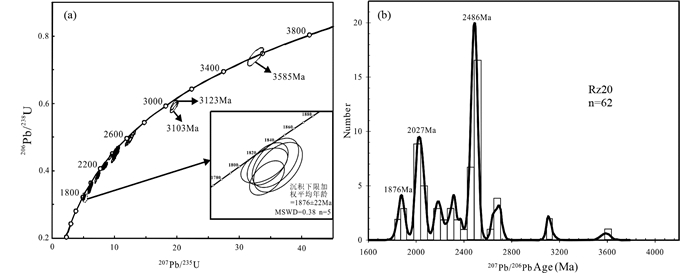
|
图 5 榆树砬子岩组Rz20碎屑锆石谐和图(a)和年龄谱图(b) Fig. 5 Concordia diagram (a) and age spectrum (b) of Sample Rz20 from the Yushulazi Formation |
样品Rz22的锆石呈浅玫瑰色,浑圆粒状、柱粒状,磨圆度较高,其中70颗谐和锆石的年龄测试结果见表 2和图 6a。碎屑锆石CL图像大都显示岩浆结构(图 4b),Th/U比值变化范围为0.12~1.69,表明这些锆石主要来自岩浆源区(Belousova et al., 2002)。除1颗年龄为~3242Ma的锆石,其余锆石年龄可分为三组:最大峰值年龄为2492Ma,次峰值年龄为1877Ma和2188Ma(图 6b)。其中谐和线附近最年轻的5颗锆石加权平均年龄为1841Ma,代表沉积时代晚于1841Ma。
|
|
表 2 榆树砬子岩组Rz22碎屑锆石的LA-ICP-MS U-Pb同位素分析结果 Table 2 LA-ICP-MS U-Pb analyses of detrital zircons from Sample Rz22 from the Yushulazi Formation |

|
图 6 榆树砬子岩组Rz22碎屑锆石谐和图(a)和年龄谱图(b) Fig. 6 Concordia diagram (a) and age spectrum (b) of Sample Rz22 from the Yushulazi Formation |
样品Rz23的锆石呈浅玫瑰色,次浑圆柱粒状、粒状,晶棱晶锥均已钝化,其中69颗谐和锆石的年龄测试结果见表 3。在CL图像(图 4c)中,绝大多数锆石内部具岩浆振荡环带,结合其较高Th/U(0.21~1.49)比值,指示其岩浆成因特点(Belousova et al., 2002)。该样品的锆石年龄较复杂(图 7a),介于3457~1795Ma之间,除1颗年龄为~3457Ma的锆石外,其余锆石年龄可分为三组:最大峰值年龄为1852Ma,次峰值年龄为2127Ma和2485Ma(图 7b)。其中谐和线附近最年轻的5颗锆石加权平均年龄为1816Ma,表明沉积时代晚于1816Ma。
|
|
表 3 榆树砬子岩组Rz23碎屑锆石的LA-ICP-MS U-Pb同位素分析结果 Table 3 LA-ICP-MS U-Pb analyses of detrital zircons from Sample Rz23 from the Yushulazi Formation |
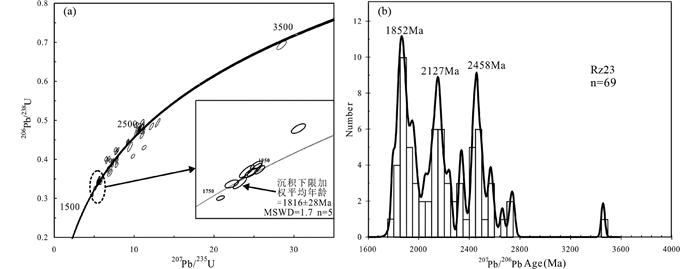
|
图 7 榆树砬子岩组Rz23碎屑锆石谐和图(a)和年龄谱图(b) Fig. 7 Concordia diagram (a) and age spectrum (b) of Sample Rz23 from the Yushulazi Formation |
样品Rz24的锆石呈黄粉色为主,浑圆柱状、柱粒状,粒径0.02~0.2mm,磨圆度较高,其中69颗谐和锆石的年龄测试结果见表 4。绝大多数锆石具明显的岩浆振荡环带(图 4d)和较高的Th/U(0.15~1.77)比值,指示其岩浆成因特点(Belousova et al., 2002)。碎屑锆石年龄较复杂(图 8a),锆石年龄大体可分为四组:最大峰值年龄为2495Ma,次峰值年龄为1924Ma、2154Ma、1830Ma(图 8b)。此外,样品中还存在2颗较老的~3.3Ga的锆石。谐和线附近最年轻的4颗锆石加权平均年龄为1803Ma,表明沉积时代晚于1803Ma。
|
|
表 4 榆树砬子岩组Rz24碎屑锆石的LA-ICP-MS U-Pb同位素分析结果 Table 4 LA-ICP-MS U-Pb analyses of detrital zircons from Sample Rz24 from the Yushulazi Formation |
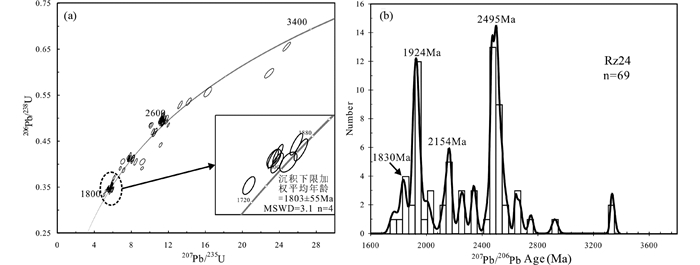
|
图 8 榆树砬子岩组Rz24碎屑锆石谐和图(a)和年龄谱图(b) Fig. 8 Concordia diagram (a) and age spectrum (b) of Sample Rz24 from the Yushulazi Formation |
在榆树砬子岩组4件样品中,按不同U-Pb年龄段选取100颗锆石进行Hf同位素分析,结果见表 5。
|
|
表 5 榆树砬子岩组锆石Hf同位素数据 Table 5 Analytical results of zircon Hf isotope from the Yushulazi Formation |
样品Rz20中24个点的176Hf/177Hf=0.281765~0.280480,176Lu/177Hf=0.001485~0.000242,176Yb/177Hf=0.057689~0.007618,207Pb/206Pb年龄由3585~1853Ma,εHf(t)值为-9.9~+8.4,二阶段模式年龄为4.16~2.18Ga,峰期落在~3.0Ga地壳演化线附近,此外,有εHf(t)<0的三个点落在~4.1Ga镁铁质地壳演化线附近(图 9a)。

|
图 9 榆树砬子岩组锆石Hf同位素特征 (a)样品Rz20; (b)样品Rz22; (c)样品Rz23; (d)样品Rz24 Fig. 9 The characteristics of zircon Hf isotope from the Yushulazi Formation (a) Sample Rz20; (b) Sample Rz22; (c) Sample Rz23; (d) Sample Rz24 |
样品Rz22中24个点的176Hf/177Hf=0.281671~0.280607,176Lu/177Hf=0.001970~0.000335,176Yb/177Hf=0.058005~0.009244,207Pb/206Pb年龄由3242~1828Ma,εHf(t)值为-9.7~+4.9,二阶段模式年龄为4.13~2.49Ga,峰期集中在3.6~2.5Ga之间(图 9b)。
Rz23中26个点的176Hf/177 Hf=0.281649~0.280667,176Lu/177Hf=0.003024~0.000312,176Yb/177Hf=0.098247~0.012544,207Pb/206Pb年龄由3457~1806Ma,εHf(t)值为-13.6~+4.9,二阶段模式年龄为4.1~2.57Ga,峰期集中在3.6~2.5Ga之间,此外,有εHf(t)<0的3个点落在~4.1Ga镁铁质地壳演化线附近(图 9c)。
Rz24中26个点的176Hf/177Hf=0.281640~0.280394,176Lu/177Hf=0.001399~0.000194,176Yb/177Hf=0.059018~0.008506,εHf(t)值为-15.1~~+5.0,二阶段模式年龄为4.40~2.59Ga,峰期集中在3.6~2.5Ga之间(图 9d)。
5 讨论 5.1 榆树砬子岩组沉积时限榆树砬子组由长春地质学院辽东区测大队(1960)首次建名,并将其划分为上辽河群,时代置于太古代。姜春潮(1973①)认为辽河群榆树砬子组时代应归属元古代。东北地质科学研究情报组将榆树砬子组从辽河群划分到新元古界震旦系底部。随后,有学者将榆树砬子组改称为“榆树砬子群”,时代置于元古代。张秋生等(1988)将榆树砬子群与庄河步云山地区的永宁组合称为“步云山群”,并改榆树砬子群为榆树砬子岩组,时代归属古元古代。辽宁地矿局区调队(1992)在15万区调中仍沿用“榆树砬子群”,根据年代学资料将其划分到新元古代。Luo et al.(2006)对盖州市东北部云山沟地区“榆树砬子岩组”中的绢云石英片岩进行了锆石U-Pb年代学研究,认为其沉积时代为1.05~0.9Ga之间。于海峰等(2010)得到榆树砬子岩组泥质岩石的全岩Rb-Sr等时线变质年龄为1025±28Ma,并认为其沉积时代早于1000Ma。综上所述,前人对榆树砬子岩组的形成时代具有较大争议,主要原因是明显缺乏野外地层关系和高精度测年的共同制约。例如,Luo et al.(2006)并没有提供明确的榆树砬子岩组与永宁组的野外地层接触关系及地层剖面的控制。事实上,永宁组在岩性上与榆树砬子岩组具有相似性,因此已报道年龄能否严格区分二者沉积时限仍然值得商榷。相比,本文首先完成野外实测地层剖面(12000)(图 2),在确定榆树砬子岩组与上覆永宁组及下伏盖县岩组接触关系基础上,分别在榆树砬子岩组底部、中部及顶部进行了采样,所分析的268颗谐和锆石年龄中,最年轻的一组碎屑锆石年龄值为1803Ma,并没有发现ca.1.2~1.0Ga的年龄记录,只能表明其沉积时间晚于1803Ma,但关于其沉积的下限仍需要进一步的研究。
① 姜春潮.1973.辽宁省东部前震旦纪地层的划分对比问题.东北地质科技情报
5.2 榆树砬子岩组物源区古元古代碰撞造山事件造成研究区的辽河群褶皱隆起,至榆树砬子岩组沉积时期,盖州至庄河一带发生沉降并接受沉积,以砂级碎屑为主,夹少量泥质,岩层中发育波痕、水平层理、交错层理和斜层理等原生沉积构造,地层层序呈明显的旋回性特征,退积型与进积型层序结构交替出现,反映海平面不断的升降变化。从榆树砬子岩组所处构造位置,其潜在的物源区可能包括辽吉活动带、北侧龙岗地块及南侧的辽南地块。
碎屑锆石年龄分析是限定沉积岩物源区的有效办法(Wysoczanski et al., 1997; Geslin et al., 1999; Böhm et al., 2000; Cawood and Nemchin, 2000)。榆树砬子岩组的石英含量可达95%以上,其源区物质必然经过了较长距离的搬运和磨蚀。因此,其具有较高的结构成熟度和成分成熟度的特点。本文3件石英岩样品(Rz20、Rz22、Rz24)、1件千枚岩样品(Rz23)内碎屑锆石Th/U比值偏高,大部分锆石阴极发光显示明显或弱的振荡环带,指示岩浆成因。锆石U-Pb定年结果显示,榆树砬子岩组样品中主要存在1900~1800Ma、2200~2100Ma、2600~2480Ma等三组年龄。其中,1900~1800Ma这组锆石年龄与胶-辽-吉活动带内广泛发育的同碰撞-碰撞后花岗岩的年龄一致,例如坎子花岗岩(1894Ma, 未发表)、卧龙泉巨斑状花岗岩(1883Ma, 未发表)、矿洞沟正长岩(1870Ma, 杨进辉等, 2007)等。此外,样品中2200~2100Ma这组锆石年龄与胶-辽-吉活动带内的辽吉花岗岩和辽河群变质火山岩的年龄结果相一致(Lu et al., 2002; Li and Zhao, 2007; Li and Chen, 2014)。因此,胶-辽-吉活动带很可能是榆树砬子组的主要物源区之一。2600~2480Ma这组新太古代晚期的年龄在龙岗地块和辽南陆块均有大量报道(万渝生等, 2005; Wang et al., 2016;王伟等, 2017),表明二者也为榆树砬子岩组提供了物源。同时,样品中还存在许多古-中太古代古老年龄,包括~2.7Ga、~2.8Ga、ca.3.5~3.1Ga的锆石年龄记录,这与龙岗地块内鞍山地区、栾家街地区发现的古老岩石年龄相关(万渝生等, 2001, 2009; Jiang et al., 2010; Wang et al., 2012; Liu et al., 2017a),也可能代表了其中的物源区。
5.3 与燕辽裂谷带内常州沟组的对比常州沟组是燕辽裂谷带内长城系最底部的沉积,前人对其年代学方面做了大量的工作(王松山等, 1995;万渝生等, 2003;和政军等, 2011;李怀坤等, 2011;彭澎等, 2011;乔秀夫和王彦斌, 2014;张艳斌和李秋立, 2017),但确切的沉积时限一直难以准确测定。王松山等(1995)利用黑云母Ar40/Ar39法对北京十三陵地区被常州沟组不整合沉积覆盖的角闪斜长片麻岩进行定年,获得1782±3Ma,故认为常州沟组沉积时代晚于1782Ma。万渝生等(2003)对常州沟组的长石石英砂岩运用SHRIMP方法进行锆石U-Pb测年,得到最年轻的峰值为1.80Ga,指示常州沟组形成年龄晚于1.80Ga。彭澎等(2011)利用同位素稀释法获得了密云水库附近的岩墙群年龄1731±4Ma,根据岩墙被长城系底部常州沟组底砾岩不整合覆盖,认为常州沟组沉积起始晚于1731Ma。李怀坤等(2011)对被常州沟组不整合覆盖的花岗斑岩岩脉采用LA-ICP-MS进行锆石U-Pb同位素年龄测定,获得了1.67Ga的侵位年龄,表明常州沟组年龄小于1.67Ga。和政军等(2011)在北京密云地区,采用SHRIMP和LA-ICP-MS方法分别获得被长城系常州沟组砂岩覆盖的环斑花岗岩古风化壳年龄为1682Ma和1708Ma,因此推测常州沟组年龄应小于1682Ma。张艳斌和李秋立(2017)在上覆串岭沟组砂岩中获得自生磷钇矿生长年龄1716Ma,进而限定下部常州沟组沉积时代老于1716Ma。综合前人的研究成果,常州沟组的沉积时代至少晚于1.8Ga,而本文榆树砬子岩组的沉积时代也是晚于1.8Ga。我们进一步将榆树砬子岩组与北京十三陵地区、天津蓟县剖面常州沟组的锆石年龄谱进行对比(图 10),发现三者碎屑锆石年龄峰值较为相似,主要分布在2.60~2.40Ga、2.30~2.10Ga、1.90~1.80Ga区间,碎屑沉积物主要来源于~2.50Ga陆壳物质为主的华北克拉通物源区,2.30~2.10Ga为古元古代岩浆作用年龄,1.90~1.80Ga为华北克拉通古元古代陆-陆碰撞构造热事件响应的年龄(万渝生等, 2003)。
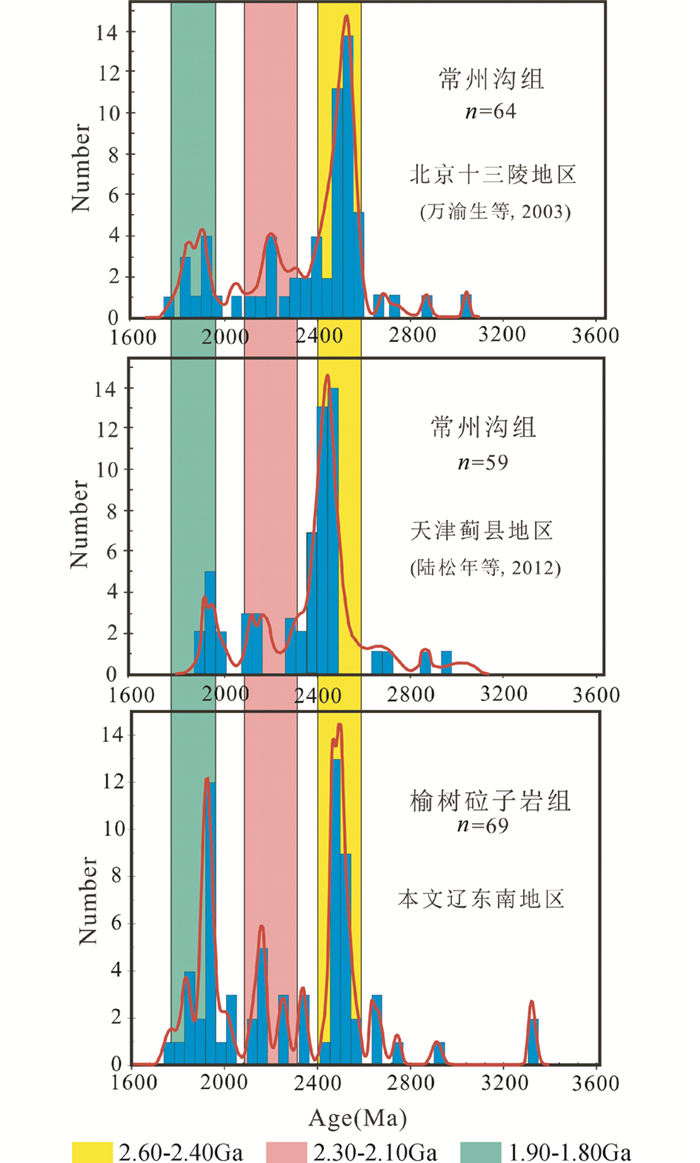
|
图 10 榆树砬子岩组与常州沟组年龄谱图 Fig. 10 Age spectrum of the Yushulazi Formation and Changhzougou Formation |
从沉积构造背景角度来看,前人将常州沟组分为三个沉积旋回,下部为石英质砾岩、含砾粗砂岩,中部为石英砂岩与粉砂质泥岩互层,顶部为厚层石英岩,常州沟组也被称之为“长城石英岩”(钟焱等, 2011)。而榆树砬子岩组下部为变质石英砾岩,中部为石英岩与绢云千枚岩互层,上部为巨厚层石英岩。通过地层柱状图对比(图 11),榆树砬子岩组与常州沟组的岩石组合、沉积旋回序列较为相似。同时,二者底部均发育一套砾岩序列,砾石成分主要为石英岩,分选性和磨圆度较好,具较高的结构、成分成熟度,为海成砾岩(图 12a, b),近些年有学者(钟焱等, 2011)通过对常州沟底部层位进行宏观(图 12a)、微观沉积特征(粒度分析)方面研究,认为其应属滨浅海沉积环境。榆树砬子岩组虽遭受绿片岩相浅变质作用的改造,但其宏观层序性、原生层理及沉积构造均清晰可辨,发育低角度冲洗楔状层理和波痕构造,同样具有滨浅海相沉积环境特征(辽宁省地质矿产局, 1989)。
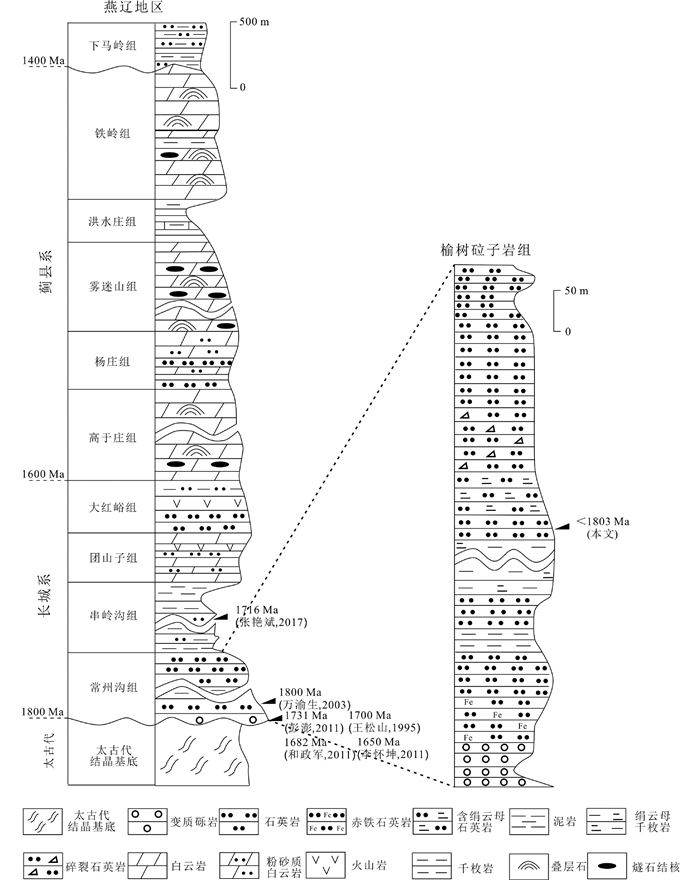
|
图 11 榆树砬子岩组与燕辽地区常州沟组对比柱状图 Fig. 11 Comparison of the Mesoproterozoic stratigraphic columns between the Yushulazi Formation and the Changzhougou Formation in Yanliao area |

|
图 12 天津蓟县剖面常州沟组(a, 箭头指示砾石排列的优势方向, 钟焱等, 2011)和辽宁盖州地区榆树砬子岩组底部堆积的砾石层(b) Fig. 12 Conglomerate at the bottom of the Changzhougou Formation from the Jixian Section in Tianjin (a, arrows indicating the preferred orientation of the pebbles, Zhong et al., 2011) and conglomerate from the Yushulazi Formation of the Gaizhou area, Liaoning (b) |
因此,燕辽地区的常州沟组与辽东地区的榆树砬子岩组在锆石年龄谱、岩石组合、沉积层序、物源及沉积环境等方面是可以对比的。但本次对榆树砬子岩组的锆石年代学研究仅能得出其沉积时代应晚于1803Ma,早于上伏不整合覆盖的永宁组(0.9~0.8Ga),其沉积时代还缺少有效限定。因此,榆树砬子岩组是否真正与常州沟组有成因联系,还需进一步的年代学和岩相古地理的证据。
5.4 对华北克拉通前寒武纪陆壳演化的意义锆石Hf同位素分析显示(图 13a),2.0~1.75Ga碎屑锆石的εHf(t)值在-10.7~3.1之间,εHf(t)>0的二阶段Hf模式年龄在2839~2491Ma之间,平均值为2686Ma,εHf(t)<0的二阶段Hf模式年龄在3643~2571Ma之间,平均值为2967Ma;2.5~2.0Ga碎屑锆石的εHf(t)值在-13.6~8.4之间,εHf(t)>0的二阶段Hf模式年龄在3090~2182Ma之间,平均值为2842Ma,εHf(t)<0的二阶段Hf模式年龄在4089~2825Ma之间,平均值为3444Ma;3.0~2.5Ga碎屑锆石的εHf(t)值在-15.1~4.9之间,εHf(t)>0的二阶段Hf模式年龄在3179~2726Ma之间,平均值为2954Ma,εHf(t)<0的二阶段Hf模式年龄在4138~3447Ma之间,平均值为3840Ma;>3.0Ga碎屑锆石的εHf(t)值全部为负值,二阶段Hf模式年龄在4341~3823Ma之间,平均值为4125Ma。
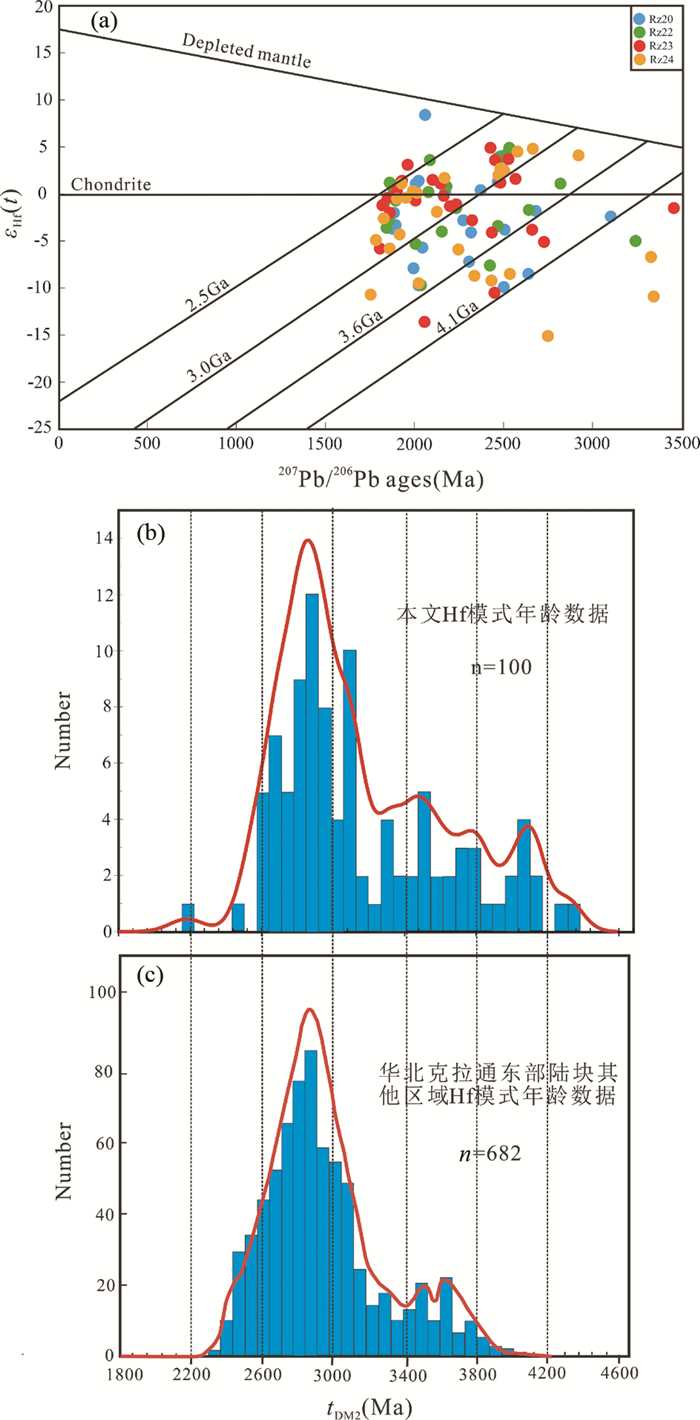
|
图 13 榆树砬子岩组锆石εHf(t)-Age图(a)、二阶段年龄谱图(b)和华北克拉通其他区域前寒武纪地质体的二阶段Hf模式年龄图(c) 数据来自: Wu et al., 2008, 2016;万渝生等, 2009;任荣等, 2011; Liu et al., 2017b; Meng et al., 2017 Fig. 13 εHf(t) vs. age plot (a) and two-stage Hf model ages (b) for zircons from the Yushulazi Formation, and two-stage Hf model ages of the adjacent Precambrian domains of the North China Craton (c) Data from: Wu et al., 2008, 2016; Wan et al., 2009; Ren et al., 2011; Liu et al., 2017b; Meng et al., 2017 |
综上,榆树砬子岩组的二阶段Hf模式年龄远大于锆石结晶年龄(表 5),碎屑锆石的物源区岩石形成于古老陆壳(~3.0Ga、~3.4Ga、~3.8Ga、~4.1Ga)的再循环,同时也存在3.0~2.7Ga的地壳生长事件。由图 13a, b反应华北克拉通东部辽东地区地壳生长主要发生在4.1~2.5Ga期间,峰值在3.1~2.7Ga,这与华北克拉通其他地区Hf模式年龄反应的结果相一致(图 13c, Wu et al., 2008, 2016;万渝生等, 2009;任荣等, 2011; Liu et al., 2017b; Meng et al., 2017)。
本文发现9颗锆石落在~4.1Ga或>4.1Ga的地壳演化线上,且εHf(t)值均为负值,指示了华北克拉通东北部辽东南地区可能曾经存在过~4.1Ga,甚至>4.1Ga的古老地壳。近些年,在华北克拉通不同地区也有关于~4.1Ga二阶段Hf模式年龄的报道(Wan et al., 2005;肖志斌等, 2017),甚至还有~4.1Ga锆石年龄的报道(第五春荣等, 2010b)。结合本文研究,华北克拉通可能存在~4.1Ga地壳生长事件。
6 结论(1) 作为不整合覆盖于辽河群之上的榆树砬子岩组,其沉积时代晚于1803Ma,沉积物主要来自于两侧龙岗地块和狼林地块的太古宙基底(2500~2480Ma)、辽吉花岗岩和辽河群变质火山岩(2200~2100Ma)、古元古代末期同碰撞或碰撞后期岩浆岩(1900~1800Ma)等。
(2) 锆石年龄谱、物源成分、沉积层序及沉积环境等特征,揭示榆树砬子岩组与常州沟组可能具有一定的相似性和亲缘性。
(3) 锆石Hf同位素结果指示华北克拉通可能存在~4.1Ga的地壳生长事件,并在ca. 3.1~2.7Ga期间经历了大规模的地壳生长。
致谢 在野外工作中,得到了吉林大学刘正宏教授的悉心指导;在本文撰写过程中,沈阳地调中心李东涛教授级高级工程师、东北大学巩恩普教授给予了笔者热心的指导和帮助;在锆石LA-ICP-MS U-Pb及Hf同位素测试分析中,北京燕都中实测试技术有限公司实验室张晗博士给予了笔者大力支持和帮助;在此,对以上提及的专家表示衷心的感谢。同时,也衷心感谢审稿人龙晓平教授、第五春荣教授、刘超辉研究员、张艳斌副研究员对本文提出了宝贵的修改意见。
Amelin Y, Lee DC, Halliday AN and Pidgeon RT. 1999. Nature of the Earth's earliest crust from hafnium isotopes in single detrital zircons. Nature, 399: 252-255 DOI:10.1038/20426 |
Amelin Y and Davis WJ. 2005. Geochemical test for branching decay of 176Lu. Geochimica et Cosmochim Acta, 69: 465-473 DOI:10.1016/j.gca.2004.04.028 |
Belousova EA, Griffin WL, O'Reilly SY and Fisher NI. 2002. Igneous zircon:Trace element composition as an indicator of source rock type. Contributions to Mineralogy and Petrology, 143(5): 602-622 DOI:10.1007/s00410-002-0364-7 |
Bouvier A, Vervoort JD and Patchett PJ. 2008. The Lu-Hf and Sm-Nd isotopic composition of CHUR:Constraints from un-equilibrated chondrites and implications for the bulk composition of terrestrial planets. Earth and Planetary Science Letters, 273(1-2): 48-57 DOI:10.1016/j.epsl.2008.06.010 |
Böhm CO, Heaman LM, Creaser RA and Corkery MT. 2000. Discovery of pre-3.5Ga exotic crust at the northwestern Superior Province margin, Manitoba. Geology, 28(1): 75-78 |
Bureau of Geology and Mineral Exploration of Liaoning Province. 1992. 1:50000 Regional Geological Survey Report of Bangshipu. Beijing: Geological Publishing House: 1-324 (in Chinese)
|
Bureau of Geology and Mineral Resources of Liaoning Province. 1989. Regional Geology of Liaoning Province. Beijing: Geological Publishing House: 1-856 (in Chinese)
|
Cawood PA and Nemchin AA. 2000. Provenance record of a rift basin:U/Pb ages of detrital zircons from the Perth Basin, Western Australia. Sedimentary Geology, 134(3-4): 209-234 DOI:10.1016/S0037-0738(00)00044-0 |
Changchun College of Geology. 1960. 1:200000 Regional Geological Survey Report of Jinxian. Beijing: Geological Publishing House: 1-278 (in Chinese)
|
Diwu CR, Sun Y, Liu L, Zhang CL and Wang HL. 2010a. The disintegration of Kuanping Group in the North Qinling orogenic belts and Neo-Proterozoic N-MORB. Acta Petrologica Sinica, 26(7): 2025-2038 (in Chinese with English abstract) |
Diwu CR, Sun Y, Dong ZC, Wang HL, Chen DL, Chen L and Zhang H. 2010b. In situ U-Pb geochronology of Hadean zircon xenocryst (4.1~3.9Ga) from the western of the North Qinling Orogenic Belt. Acta Petrologica Sinica, 26(4): 1171-1174 (in Chinese with English abstract) |
Geslin JK, Link PK and Fanning CM. 1999. High-precision provenance determination using detrital-zircon ages and petrography of Quaternary sands on the eastern Snake River Plain, Idaho. Geology, 27(4): 295-298 |
Griffin WL, Pearson NJ, Belousova EA, Jackson SE, van Achterbergh E, O'Reilly SY and Shee SR. 2000. The Hf isotope composition of cratonic mantle:LAM-MC-ICPMS analysis of zircon megacrysts in kimberlites. Geochimica et Cosmochimica Acta, 64(1): 133-147 DOI:10.1016/S0016-7037(99)00343-9 |
Griffin WL, Belousova EA, Shee SR, Pearson NJ and O'Reilly SY. 2004. Archean crustal evolution in the northern Yilgarn Craton:U-Pb and Hf-isotope evidence from detrital zircons. Precambrian Research, 131: 231-282 DOI:10.1016/j.precamres.2003.12.011 |
He ZJ, Niu BG, Zhang XY, Zhao L and Liu RY. 2011. Discovery of the paleo-weathered mantle of the rapakivi granite covered by the Proterozoic Changzhougou Formation in the Miyun area, Beijing and their detrital zircon dating. Geological Bulletin of China, 30(5): 798-802 (in Chinese with English abstract) |
Hou KJ, Li YH, Zou TR, Qu XM, Shi YR and Xie GQ. 2007. Laser Ablation-MC-ICP-MS technique for Hf isotope microanalusis of zircon and its geological applications. Acta Petrologica Sinica, 23(10): 2595-2604 (in Chinese with English abstract) |
Jiang CC. 1987. Precambrian Geology in Eastern Liaoning-Jilin Area. Shenyang: Liaoning Science and Technology Press: 10-36 (in Chinese)
|
Jiang N, Guo JH, Zhai MG and Zhang SQ. 2010. ~2.7Ga crust growth in the North China Craton. Precambrian Research, 179(1-4): 37-49 DOI:10.1016/j.precamres.2010.02.010 |
Kusky TM, Li JH and Tucker RD. 2001. The Archean Dongwanzi ophiolite complex, North China Craton:2.505-billion-year-old oceanic crust and mantle. Science, 292(5519): 1142-1145 DOI:10.1126/science.1059426 |
Li HK, Su WB, Zhou HY, Geng JZ, Xiang ZQ, Cui YR, Liu WC and Lu SN. 2011. The base age of the Changchengian System at the northern North China Craton should be younger than 1670Ma:Constrains from zircon U-Pb LA-MC-ICPMS dating of a granite porphyry dike in Miyun Country, Beijing. Earth Science Frontiers, 18(3): 108-120 (in Chinese with English abstract) |
Li QL, Chen FK, Guo JH, Li XH, Yang YH and Siebel W. 2007. Zircon age and Nd-Hf isotopic composition of the Zhaertai Group (Inner Mongolia):Evidence for Early Proterozoic evolution of the northern North China Craton. Journal of Asian Earth Sciences, 30(3-4): 573-590 DOI:10.1016/j.jseaes.2007.01.006 |
Li SZ and Zhao GC. 2007. SHRIMP U-Pb zircon geochronology of the Liaoji granitoids:Constraints on the evolution of the Paleoproterozoic Jiao-Liao-Ji belt in the Eastern Block of the North China Craton. Precambrian Research, 158(1-2): 1-16 DOI:10.1016/j.precamres.2007.04.001 |
Li SZ, Zhao GC, Wild SA, Zhang J, Sun M, Zhang GW and Dai LM. 2010. Deformational history of the Hengshan-Wutai-Fuping complex:Implication for the evolution of the Trans-North China Orogen. Gondwana Research, 18(4): 611-631 DOI:10.1016/j.gr.2010.03.003 |
Li SZ, Li XY, Dai LM, Liu X, Zhang Z, Zhao SJ, Guo LL, Zhao GC and Zhang GW. 2015. Precambrain geodynamics (Ⅵ):Formation of North China Craton. Earth Science Frontiers, 22(6): 77-96 (in Chinese with English abstract) |
Li Z and Chen B. 2014. Geochronology and geochemistry of the Paleoproterozoic meta-basalts from the Jiao-Liao-Ji Belt, North China Craton:Implications for petrogenesis and tectonic setting. Precambrian Research, 255(2): 653-667 |
Liu CH and Liu FL. 2015. The Mesoproterozoic rifting in the North China Craton:A case study for magmatism and sedimentation of the Zhaertai-Bayan Obo-Huade rift zone. Acta Petrologica Sinica, 31(10): 3107-3128 (in Chinese with English abstract) |
Liu J, Liu ZH, Zhao C, Wang CJ, Peng YB and Zhang H. 2017a. Petrogenesis and zircon LA-ICP-MS U-Pb dating of newly discovered Mesoarchean gneisses on the northern margin of the North China Craton. International Geology Review, 59(12): 1575-1589 DOI:10.1080/00206814.2017.1285729 |
Liu SW, Wang MJ, Wan YS, Guo RR, Wang W, Wang Kang, Guo BR, Fu JH and Hu FY. 2017b. A reworked~3.45Ga continental microblock of the North China Craton:Constraints from zircon U-Pb-Lu-Hf isotopic systematics of the Archean Beitai-Waitoushan migmatite-syenogranite complex. Precambrian Research, 303: 332-354 DOI:10.1016/j.precamres.2017.04.003 |
Liu YS, Hu ZC, Gao S, Günther D, Xu J, Gao CG and Chen HH. 2008. In situ analysis of major and trace elements of anhydrous minerals by LA-ICP-MS without applying an internal standard. Chemical Geology, 257(1-2): 34-43 DOI:10.1016/j.chemgeo.2008.08.004 |
Lu SN, Yang CL, Li HK and Li HM. 2002. A group of rifting events in the terminal Paleoproterozoic in the North China Craton. Gondwana Research, 5(1): 123-131 DOI:10.1016/S1342-937X(05)70896-0 |
Lu SN, Xiang ZQ, Li HK, Wang HC and Chu H. 2012. Response of the North China Craton to Rodinia supercontinental events:GOSEN joining hypothesis. Acta Geologica Sinica, 86(9): 1396-1406 (in Chinese with English abstract) |
Luo Y, Sun M, Zhao GC, Li SZ and Xia XP. 2006. LA-ICP-MS U-Pb zircon geochronology of the Yushulazi Group in the Eastern Block, North China Craton. International Geology Review, 48(9): 828-840 DOI:10.2747/0020-6814.48.9.828 |
Meng E, Wang CY, Li YG, Li Z, Yang H, Cai J, Ji L and Jin MQ. 2017. Zircon U-Pb-Hf isotopic and whole-rock geochemical studies of Paleoproterozoic metasedimentary rocks in the northern segment of the Jiao-Liao-Ji Belt, China:Implications for provenance and regional tectonic evolution. Precambrian Research, 298: 472-489 DOI:10.1016/j.precamres.2017.07.004 |
Peng P, Zhai MG, Li QL, Wu FY, Hou QL, Li Z, Li TS and Zhang YB. 2011. Neoproterozoic (~900Ma) Sariwon sills in North Korea:Geochronology, geochemistry and implications for the evolution of the south-eastern margin of the North China Craton. Gondwana Research, 20(1): 243-254 DOI:10.1016/j.gr.2010.12.011 |
Peng P, Liu F, Zhai MG and Guo JH. 2012. Age of the Miyun dyke swarm:Constraints on the maximum depositional age of the Changcheng System. Chinese Science Bulletin, 57(1): 105-110 |
Qiao XF and Gao LZ. 2007. Mesoproterozoic palaeoearthquake and palaogeography in Yan-Liao Aulacogen. Journal of Palaeogeography, 9(4): 337-352 (in Chinese with English abstract) |
Qiao XF and Wang YB. 2014. Discussions on the lower boundary age of the Mesoproterozoic and basin tectonic evolution of the Mesoproterozoic in North China Craton. Acta Geologica Sinica, 88(9): 1623-1637 (in Chinese with English abstract) |
Ren R, Han BF, Zhang ZC, Li JF, Yang YH and Zhang YB. 2011. Zircon U-Pb and Hf isotopic studies of basement gneiss and overlying Meso-Neoproterozoic sedimentary rocks from the Changping area, Beijing, and their geological implications. Acta Petrologica Sinica, 27(6): 1721-1745 (in Chinese with English abstract) |
Song TR. 2007. Sedimentary facies indicators and sedimentary environments models of the Changcheng System of Mesoproterozoic in Ming Tombs District, Beijing. Journal of Palaeogeography, 9(5): 461-476 (in Chinese with English abstract) |
Tam PY, Zhao GC, Liu FL, Zhou XW, Sun M and Li SZ. 2011. Timing of metamorphism in the Paleoproterozoic Jiao-Liao-Ji Belt:New SHRIMP U-Pb zircon dating of granulites, gneisses and marbles of the Jiaobei massif in the North China Craton. Gondwana Research, 19(1): 150-162 DOI:10.1016/j.gr.2010.05.007 |
Tian ZH, Liu LS and Dong YS. 2017. Geodynamic origin of the earliest tectonic event (D1) and its related structural elements in the Paleoproterozoic Liaohe Group, central Jiao-Liao-Ji structural belt. Acta Petrologica Sinica, 33(9): 2758-2774 (in Chinese with English abstract) |
Wan YS, Song B, Liu DY, Li HM, Yang C, Zhang QD, Yang CH, Geng YS and Shen QH. 2001. Geochronology and Geochemistry of 3.8~2.5Ga ancient rock belt in the Dongshan Scenic Park, Anshan area. Acta Gelogica Sinica, 75(3): 363-370 (in Chinese with English abstract) |
Wan YS, Zhang QD and Song TR. 2003. SHRIMP age of detrital zircons from the Changcheng System in the Ming Tomb area, Beijing:Constraints on the protolith nature and maximum depositional age of the Mesoproterozoic cover of the North China Craton. Chinese Science Bulletin, 48(22): 2500-2506 |
Wan YS, Song B, Yang C and Liu DY. 2005. Zircon Shrimp U-Pb geochronology of Archaean rocks from the Fushun-Qingyuan area, Liaoning Province and its geological significance. Acta Geologica Sinica, 79(1): 78-87 (in Chinese with English abstract) |
Wan YS, Liu DY, Song B, Wu JS, Yang CH, Zhang ZQ and Geng YS. 2005. Geochemical and Nd isotopic compositions of 3.8Ga meta-quartz dioritic and trondhjemitic rocks from the Anshan area and their geological significance. Journal of Asian Earth Sciences, 24(5): 563-575 DOI:10.1016/j.jseaes.2004.02.009 |
Wan YS, Liu DY, Dong CY, Nutman A, Wilde SA, Wang W, Xie HQ, Yin XY and Zhou HY. 2009. The oldest rocks and zircons in China. Acta Petrologica Sinica, 25(8): 1793-1807 (in Chinese with English abstract) |
Wang SS, Sang HQ, Qiu J, Chen ME and Li MR. 1995. The metamorphic age of Pre-Changcheng System in Beijing-Tianjin area and a discussion about the lower limit age of Changcheng System. Scientia Geologica Sinica, 30(4): 348-354 (in Chinese with English abstract) |
Wang W, Liu SW, Wilde, S A, Li QG, Zhang J, Bai X, Yang PT and Guo RR. 2012. Petrogenesis and geochronology of Precambrian granitoid gneisses in western Liaoning Province:Constraints on Neoarchean to Early Paleoproterozoic crustal evolution of the North China Craton. Precambrian Research, 222-223: 290-311 DOI:10.1016/j.precamres.2011.10.023 |
Wang W, Liu SW, Cawood, P A, Bai X, Guo RR, Guo BR and Wang K. 2016. Late Neoarchean subduction-related crustal growth in the Northern Liaoning region of the North China Craton:Evidence from~2.55 to 2.50Ga granitoid gneisses. Precambrian Research, 281: 200-223 DOI:10.1016/j.precamres.2016.05.018 |
Wang W, Yang H and Ji L. 2017. The identification of the Neoarchean 2.52~2.46Ga tectono-thermal events from the Liaonan terrain and its geological significance. Acta Petrologica Sinica, 33(9): 2775-2784 (in Chinese with English abstract) |
Wu FY, Yang YH, Xie LW, Yang JH and Xu P. 2006. Hf isotopic compositions of the standard zircons and baddeleyites used in U-Pb geochronology. Chemical Geology, 234(1-2): 105-126 DOI:10.1016/j.chemgeo.2006.05.003 |
Wu FY, Li XH, Zheng YF and Gao S. 2007. Lu-Hf isotopic systematic and their applications in petrology. Acta Petrologica Sinica, 23(2): 185-220 (in Chinese with English abstract) |
Wu FY, Zhang YB, Yang JH, Xie LW and Yang YH. 2008. Zircon U-Pb and Hf isotopic constraints on the Early Archean crustal evolution in Anshan of the North China Craton. Precambrian Research, 167(3-4): 339-362 DOI:10.1016/j.precamres.2008.10.002 |
Wu ML, Lin SF, Wan YS and Gao JF. 2016. Crustal evolution of the eastern block in the North China Craton:Constraints from zircon U-Pb geochronology and Lu-Hf isotopes of the Northern Liaoning Complex. Precambrian Research, 275: 35-47 DOI:10.1016/j.precamres.2015.12.013 |
Wysoczanski R J, Gibson G M and Ireland TR. 1997. Detrital zircon age patterns and provenance in Late Paleozoic-Early Mesozoic New Zealand terranes and development of the Paleo-Pacific Gondwana margin. Geology, 25(10): 939-942 DOI:10.1130/0091-7613(1997)025<0939:DZAPAP>2.3.CO;2 |
Xiao ZB, Wang HC, Kang JL, Bao ZA, Sun YW and Liu WG. 2017. U-Pb chronology, Hf isotope and geological implication of zircons from the Neoarchean quartzite in Changyi area, eastern Shandong. Acta Petrologica Sinica, 33(9): 2925-2938 (in Chinese with English abstract) |
Yang CH, Zhao C, Cui YS, Liu J, Peng YB, Jiang CY and Liu WB. 2018. Detrital zircon U-Pb geochronology of Paleoproterozoic marble from Liangtun area of Gaizhou in Liaodong Peninsula and its geological significance. Global Geology, 37(4): 1018-1032 (in Chinese with English abstract) |
Yu HF, Dong WD, He ZQ, Hao YL and Tan WG. 2010. Geologic process of the Sibao Cycle in the Liaodong peninsula and its tectonic significance:A case study of the Yushulazi Formation in eastern Liaoning Province. Geology and Resources, 19(3): 224-229 (in Chinese with English abstract) |
Zhai MG, Bian AG and Zhao TP. 2000. The amalgamation of the supercontinent of North China craton at the end of Neo-archaean, and its break-up during Late Palaeoproterozoic and Meso-proterozoic. Science in China (Series D), 43(Suppl.): 219-232 |
Zhai MG, Zhao GC, Zhang Q, Kusky TM and Li JH. 2002. Is the Dongwanzi complex an Archean ophiolite?. Science, 295(5557): 923 DOI:10.1126/science.295.5557.923a |
Zhai MG. 2004. 2.1~1.7Ga geological event group and its geotectonic significance. Acta Petrologica Sinica, 20(6): 1343-1354 (in Chinese with English abstract) |
Zhai MG and Peng P. 2007. Paleoproterozoic events in the North China Craton. Acta Petrologica Sinica, 23(11): 2665-2682 (in Chinese with English abstract) |
Zhai MG. 2011. Cratonization and the Ancient North China Continent:A summary and review. Science China (Earth Sciences), 54(8): 1110-1120 |
Zhai MG and Santosh M. 2011. The Early Precambrian odyssey of the North China Craton:A synoptic overview. Gondwana Research, 20(1): 6-25 DOI:10.1016/j.gr.2011.02.005 |
Zhai MG. 2012. Evolution of the North China Craton and Early Plate Tectonics. Acta Geologica Sinica, 86(9): 1335-1349 (in Chinese with English abstract) |
Zhang J, Zhao GC, Li SZ, Sun M, Chan LS, Shen WL and Liu SW. 2012. Structural pattern of the Wutai Complex and its constraints on the tectonic framework of the Trans-North China Orogen. Precambrian Research, 222-223: 212-229 DOI:10.1016/j.precamres.2011.08.009 |
Zhang J, Zhao GC, Shen WL, Li SZ and Sun M. 2015. Aeromagnetic study of the Hengshan-Wutai-Fuping region:Unraveling a crustal profile of the Paleoproterozoic Trans-North China Orogen. Tectonophysics, 662: 208-218 DOI:10.1016/j.tecto.2015.08.025 |
Zhang QS, et al. 1988. Early Crust and Deposits in Liaodong Peninsula. Beijing: Geological Publishing House: 1-574 (in Chinese)
|
Zhang SH, Zhao Y, Ye H, Hu JM and Wu F. 2013. New constraints on ages of the Chuanlinggou and Tuanshanzi formations of the Changcheng System in the Yan-Liao area in the northern North China Craton. Acta Petrologica Sinica, 29(7): 2481-2490 (in Chinese with English abstract) |
Zhang YB and Li QL. 2017. Determining the depositional age of Precambrain clastic sedimentary rocks:Diagenetic authigenic xenotime dating. Journal of Earth Sciences and Environment, 39(6): 711-720 (in Chinese with English abstract) |
Zhao GC, Wilde SA, Cawood PA and Sun M. 2001. Archean blocks and their boundaries in the North China Craton:Lithological, geochemical, structural and P-T path constraints and tectonic evolution. Precambrian Research, 107(1-2): 45-73 DOI:10.1016/S0301-9268(00)00154-6 |
Zhao GC, Sun M, Wilde SA and Li SZ. 2004. A paleo-Mesoproterozoic supercontinent:Assembly, growth and breakup. Earth-Science Review, 67(1-2): 91-123 DOI:10.1016/j.earscirev.2004.02.003 |
Zhao GC, Sun M, Wilde SA and Li SZ. 2005. Late Archean to Paleoproterozoic evolution of the North China Craton:Key issues revisited. Precambrian Research, 136(2): 177-202 DOI:10.1016/j.precamres.2004.10.002 |
Zhao GC and Cawood PA. 2012. Precambrian geology of China. Precambrian Research, 222-223: 13-54 DOI:10.1016/j.precamres.2012.09.017 |
Zhao GC, Cawood PA, Li SZ, Wilde SA, Sun M, Zhang J, He YH and Yin CQ. 2012. Amalgamation of the North China Craton:Key issues and discussion. Precambrian Research, 222-223: 55-76 DOI:10.1016/j.precamres.2012.09.016 |
Zhao GC and Zhai MG. 2013. Lithotectonic elements of Precambrian basement in the North China Craton:Review and tectonic implications. Gondwana Research, 23(4): 1207-1240 DOI:10.1016/j.gr.2012.08.016 |
Zhao TP and Zhou MF. 2009. Geochemical constraints on the tectonic setting of Paleoproterozoic A-type granites in the southern margin of the North China Craton. Journal of Asian Earth Sciences, 36(2-3): 183-195 DOI:10.1016/j.jseaes.2009.05.005 |
Zhao TP, Deng XQ, Hu GH, Zhou YY, Peng P and Zhai MG. 2015. The Paleoproterozoic-Mesoproterozoic boundary of the North China Craton and the related geological issues:A review. Acta Petrologica Sinica, 31(6): 1495-1508 (in Chinese with English abstract) |
Zheng YF, Xiao WJ and Zhao GC. 2013. Introduction to tectonics of China. Gondwana Research, 23(4): 1189-1206 DOI:10.1016/j.gr.2012.10.001 |
Zhou XW, Zhao GC, Wei CJ, Geng YS and Sun M. 2008. Metamorphic evolution and Th-U-Pb zircon and monazite geochronology of high-pressure pelitic granulites in the Jiaobei massif of the North China Craton. American Journal of Science, 308: 328-350 DOI:10.2475/03.2008.06 |
Zhong Y, Zhao LD, Chen LQ and Mei MX. 2011. New understanding of "fluvial facies" deposition of the early transgression period of Mesoproterozoic:An example from Jixian Section in Tianjin. Journal of Palaeogeography, 13(1): 21-29 (in Chinese with English abstract) |
长春地质学院辽东区测大队新金分队. 1960. 1:20万"新金县"幅区域地质测量报告书. 北京: 地质出版社: 1-278.
|
第五春荣, 孙勇, 刘良, 张成立, 王洪亮. 2010a. 北秦岭宽坪岩群的解体及新元古代N-MORB. 岩石学报, 26(7): 2025-2038. |
第五春荣, 孙勇, 董增产, 王洪亮, 陈丹玲, 陈亮, 张红. 2010b. 北秦岭西段冥古宙锆石(4.1~3.9Ga)年代学新进展. 岩石学报, 26(4): 1171-1174. |
姜春潮. 1987. 辽吉东部前寒武纪地质. 沈阳: 辽宁科学技术出版社: 10-36.
|
和政军, 牛宝贵, 张新元, 赵磊, 刘仁燕. 2011. 北京密云元古宙常州沟组之下环斑花岗岩古风化壳岩石的发现及其碎屑锆石年龄. 地质通报, 30(5): 798-802. DOI:10.3969/j.issn.1671-2552.2011.05.020 |
侯可军, 李延河, 皱天人, 曲晓明, 石玉若, 谢桂青. 2007. LA-MC-ICP-MS锆石Hf同位素的分析方法及地质应用. 岩石学报, 23(10): 2595-2604. DOI:10.3969/j.issn.1000-0569.2007.10.025 |
李怀坤, 苏文博, 周红英, 耿建珍, 相振群, 崔玉荣, 刘文灿, 陆松年. 2011. 华北克拉通北部长城系底界年龄小于1670Ma:来自北京密云花岗斑岩岩脉锆石LA-MC-ICPMS U-Pb年龄的约束. 地学前缘, 18(3): 108-120. |
李三忠, 李玺瑶, 戴黎明, 刘鑫, 张臻, 赵淑娟, 郭玲莉, 赵国春, 张国伟. 2015. 前寒武纪地球动力学(Ⅵ):华北克拉通形成. 地学前缘, 22(6): 77-96. |
辽宁地矿局区调队. 1992. 1:5万"傍式堡幅"等四幅区调联测报告. 北京: 地质出版社: 1-324.
|
辽宁省地质矿产局. 1989. 辽宁省区域地质志. 北京: 地质出版社: 1-856.
|
刘超辉, 刘福来. 2015. 华北克拉通中元古代裂解事件:以渣尔泰-白云鄂博-化德裂谷带岩浆与沉积作用研究为例. 岩石学报, 31(10): 3107-3128. |
陆松年, 相振群, 李怀坤, 王惠初, 初航. 2012. 华北克拉通对罗迪尼亚超大陆事件的响应——GOSEN连接假设. 地质学报, 86(9): 1396-1406. DOI:10.3969/j.issn.0001-5717.2012.09.006 |
彭澎, 刘富, 翟明国, 郭敬辉. 2011. 密云岩墙群的时代及其对长城系底界年龄的制约. 科学通报, 56(35): 2975-2980. |
乔秀夫, 高林志. 2007. 燕辽裂陷槽中元古代古地震与古地理. 古地理学报, 9(4): 337-350. DOI:10.3969/j.issn.1671-1505.2007.04.001 |
乔秀夫, 王彦斌. 2014. 华北克拉通中元古界底界年龄与盆地性质讨论. 地质学报, 88(9): 1623-1637. |
任荣, 韩宝福, 张志诚, 李建锋, 杨岳衡, 张艳斌. 2011. 北京昌平地区基底片麻岩和中-新元古代盖层锆石U-Pb年龄和Hf同位素研究及其地质意义. 岩石学报, 27(6): 1721-1745. |
宋天锐. 2007. 北京十三陵地区中元古界长城系沉积相标志及沉积环境模式. 古地理学报, 9(5): 461-472. DOI:10.3969/j.issn.1671-1505.2007.05.004 |
田忠华, 刘利双, 董永胜. 2017. 胶-辽-吉构造带中段古元古代辽河群早期构造事件(D1)中构造要素几何学特征及其动力学来源. 岩石学报, 33(9): 2758-2774. |
万渝生, 宋彪, 刘敦一, 李惠民, 杨淳, 张巧大, 杨崇辉, 耿元生, 沈其韩. 2001. 鞍山东山风景区3.8~2.5Ga古老岩带的同位素地质年代学和地球化学. 地质学报, 75(3): 363-370. |
万渝生, 张巧大, 宋天锐. 2003. 北京十三陵长城系常州沟组碎屑锆石SHRIMP年龄:华北克拉通盖层物源区及最大沉积年龄的限定. 科学通报, 48(18): 1970-1975. DOI:10.3321/j.issn:0023-074X.2003.18.014 |
万渝生, 宋彪, 杨淳, 刘敦一. 2005. 辽宁抚顺-清原地区太古宙岩石SHRIMP锆石U-Pb年代学及其地质意义. 地质学报, 79(1): 78-87. DOI:10.3321/j.issn:0001-5717.2005.01.009 |
万渝生, 刘敦一, 董春艳, Nutman A, Wild SA, 王伟, 颉颃强, 殷小艳, 周红英. 2009. 中国最老岩石和锆石. 岩石学报, 25(08): 1793-1807. |
王松山, 桑海清, 裘冀, 陈梦莪, 李明荣. 1995. 京津地区长城系下伏变质岩系变质年龄及长城系底界年龄的厘定. 地质科学, 30(4): 348-354. |
王伟, 杨红, 冀磊. 2017. 辽南地块新太古代2.52~2.46Ga构造-热事件的识别及地质意义. 岩石学报, 33(9): 2775-2784. |
吴福元, 李献华, 郑永飞, 高山. 2007. Lu-Hf同位素体系及其岩石学应用. 岩石学报, 23(2): 185-220. |
肖志斌, 王惠初, 康健丽, 包志安, 孙义伟, 刘文刚. 2017. 胶东昌邑地区新太古代石英岩的锆石U-Pb年代学和Hf同位素特征及其地质意义. 岩石学报, 33(9): 2925-2938. |
杨成会, 赵辰, 崔育菘, 刘锦, 彭游博, 姜春宇, 刘文彬. 2018. 辽东半岛盖州市梁屯地区古元古代大理岩的碎屑锆石U-Pb定年及地质意义. 世界地质, 37(4): 1018-1032. DOI:10.3969/j.issn.1004-5589.2018.04.003 |
杨进辉, 吴福元, 谢烈文, 柳小明. 2007. 辽东矿洞沟正长岩成因及其构造意义:锆石原位微区U-Pb年龄和Hf同位素制约. 岩石学报, 23(02): 263-276. |
于海峰, 董万德, 何振清, 郝永利, 谭文刚. 2010. 辽东半岛四堡旋回地质作用及其构造意义——以辽东榆树砬子组为例. 地质与资源, 19(03): 224-229. DOI:10.3969/j.issn.1671-1947.2010.03.007 |
翟明国. 2004. 华北克拉通2.1~1.7Ga地质事件群的分解和构造意义探讨. 岩石学报, 20(6): 1343-1354. |
翟明国, 彭澎. 2007. 华北克拉通古元古代构造事件. 岩石学报, 23(11): 2665-2682. DOI:10.3969/j.issn.1000-0569.2007.11.001 |
翟明国. 2011. 克拉通化与华北陆块的形成. 中国科学(地球科学), 41(8): 1037-1046. |
翟明国. 2012. 华北克拉通的形成以及早期板块构造. 地质学报, 86(9): 1335-1349. DOI:10.3969/j.issn.0001-5717.2012.09.002 |
张秋生, 等. 1988. 辽东半岛早期地壳与矿床. 北京: 地质出版社: 1-574.
|
张拴宏, 赵越, 叶浩, 胡健民, 吴飞. 2013. 燕辽地区长城系串岭沟组及团山子组沉积时代的新制约. 岩石学报, 29(7): 2481-2490. |
张艳斌, 李秋立. 2017. 前寒武纪碎屑岩沉积作用时间的限定:沉积自生磷钇矿定年. 地球科学与环境学报, 39(6): 711-720. DOI:10.3969/j.issn.1672-6561.2017.06.002 |
赵太平, 邓小芹, 胡国辉, 周艳艳, 彭澎, 翟明国. 2015. 华北克拉通古/中元古代界线和相关地质问题讨论. 岩石学报, 31(6): 1495-1508. |
钟焱, 赵亮东, 陈留勤, 梅冥相. 2011. 对华北中元古代海侵初期"河流相"沉积的重新认识:以天津蓟县剖面为例. 古地理学报, 13(1): 21-29. |
 2019, Vol. 35
2019, Vol. 35






































